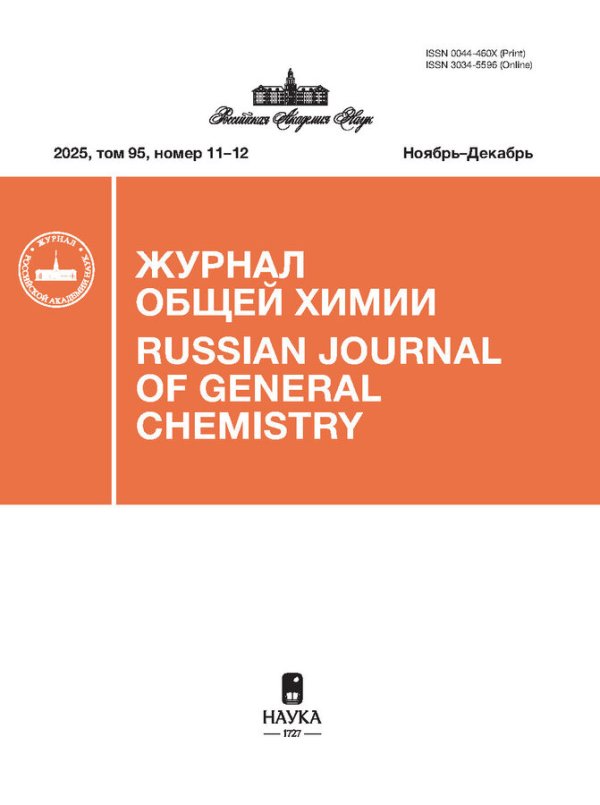Vol 94, No 3 (2024)
Articles
Role of Noncovalent Interactions in The Reaction of Bromine with Alkylacetamides
Abstract
Sequential transformations of molecular complexes and ionic intermediates lead to ionic products of nonionic bromine and alkylacetamides interaction. Molecular geometry, electron structure and thermodynamic parameters were evaluated at ωB97xV/dgdzvp level for all final products and supposed intermediates. A number of intra- and intermolecular noncovalent interactions such as Br···O, C-H···O, C-H···Br, H···O···H and other were revealed with combined use of spectral and computational methods, and defining role of these interactions in products and intermediates stabilization was demonstrated.
 315-334
315-334


Reactions of Grignard Reagents with Substituted 5-Acyl-1,3-dioxanes
Abstract
A series of tertiary alcohols was synthesized by reacting 1-(5-isopropyl-1,3-dioxan-5-yl)ethan-1-one with Grignard reagents (EtMgBr, EtMgI, AllylMgBr, AllylMgI, BnMgBr, BnMgI). The basic regularities of the reaction were established, and the optimal conditions for achieving the maximum yield of reaction products were determined. Structure of the synthesized compounds was established using spectroscopy methods (IR, 1H, ¹³C NMR, COSY, HSQC, HMBC, DEPT) and high-resolution GCMS (HRMS).
 335-341
335-341


Three-Component Synthesis of 5-Aryl(hetaryl)-4-aroyl-1-isobutyl-3-hydroxy-3-pyrroline-2-ones
Abstract
A series of new 5-aryl(hetaryl)-4-aroyl-1-isobutyl-3-hydroxy-3-pyrrolin-2-ones were synthesized by reacting methyl esters of aroylpyruvic acids with aromatic (heterocyclic) aldehydes and isobutylamine in dioxane. Antimicrobial activity of the obtained compounds was studied in vitro against Staphylococcus aureus, Escherichia coli and Candida albicans strains.
 342-349
342-349


Synthesis of 5-Aryl-1-[2-(1H-indol-3-yl)ethyl]- 4-(hydroxy-4-methylphenylmethylene)pyrrolidine-2,3-diones by Reaction of Tryptamine with 4-Methylbenzoyltartaric Acid Methyl Ester and Aromatic Aldehydes
Abstract
Short heating of a mixture of tryptamine, aromatic aldehyde and 4-methylbenzoylpyruvic acid methyl ester followed by keeping for 24 h at room temperature leads to the formation of 5-aryl-1-[2-(1H-indol-3-yl)ethyl]-4-(hydroxy-p-tolylmethylene)pyrrolidine-2,3-diones. Structure of the obtained compounds was confirmed by IR and 1H NMR spectroscopy methods. Antimicrobial activity of the obtained compounds was investigated.
 350-357
350-357


Synthesis of N-Alkyl-Substituted Aziridines and Oxazolidine Based on Levoglucosenone Derivatives
Abstract
Diastereomeric oxazolidines were obtained in quantitative yield by boiling levoglucosenone (cyrene) derivative in benzene with ethanolamine. Sterocontrolled synthesis of N-propyl, -butyl, -lauryl aziridines annulated with a pyran ring based on the α-bromoderivative of levoglucosenone and the corresponding amines was carried out under ultrasonic irradiation of the mixture in the presence of an accessible base K₂CO₃ and catalytic amounts 18-crown-6-ether in toluene. The obtained nitrogen-containing heterocycles are promising in terms of structure–activity studies in the synthesized series of compounds.
 358-363
358-363


Synthesis and Structure of Piperidinium 5-(1-Aryl-3-ethoxy- 2-ethoxycarbonyl-3-oxopropyl)aminotetrazol-1-ides
Abstract
The reaction of diethyl malonate with aromatic aldehydes, 5-aminotetrazole monohydrate in ethanol in the presence of piperidine leads to the formation of piperidinium 5-(1-aryl-3-ethoxy-2-ethoxycarbonyl-3-oxopropyl)aminotetrazole-1-ides. Structure of the obtained compounds was established by IR, 1H NMR spectroscopy and single crystal X-ray diffraction analysis.
 364-369
364-369


Synthesis and Transformations of Hydrazine-Substituted Pyrano[3″,4″:5′,6′]pyrido[3′,2′:4,5]thieno[3,2-d]pyrimidine
Abstract
A method was developed for the synthesis of 11-(2-furyl)-4-hydrazino-8,8-dimethyl-7,10-dihydro-8H-pyrano[3″,4″:5′,6′]pyrido[3′,2′:4,5]thieno[3,2-d]pyrimidine on the basis of which new heterocyclic systems were synthesized. The conditions for the azido/tetrazole transformation of the resulting condensed tetrazolo[1,5-c]pyrimidine were studied. Isomeric triazolo[4,3-c]- and -[1,5-c]pyrimidines were synthesized and the conditions for the transformation of the first isomer into the second in accordance with the Dimroth rearrangement were established.
 370-375
370-375


Synthesis and Some Regularities of Transformations of 5,5-Dimethyl-3-(2-methylalyl)-2-thioxo-2,3,5,6-tetrahydrobenzo[h]quinazoline-4(1H)-one. Antibacterial Activity of the Obtained Compounds
Abstract
Based on ethyl 1-amino-3,3-dimethyl-3,4-dihydronaphthalene-2-carboxylate (amino ester), a method for the synthesis of 5,5-dimethyl-3-(2-methylallyl)-2-thioxo-2,3,5,6-tetrahydrobenzo[h]quinazoline-4(1H)-one was developed. The latter was alkylated with halides of various structures, resulting in the production of 2-alkylsulfanyl-5,5-dimethyl-3-(2-methylallyl)-5, 6-dihydrobenzo[h]quinazoline-4(3H)-ones. By condensation of thioxobenzoquinazoline with hydrazine hydrate, 2-hydrazinyl-5,5-dimethyl-3-(2-methylallyl)-5,6-dihydrobenzo[h]quinazoline-4(3H)-one was synthesized, but similar reactions with 2-ethanolamine and 3-propanolamine proceeded abnormally with the formation of 2-(2-hydroxyethyl)amino-5,5-dimethyl-5,6-dihydrobenzo[h]quinazoline-4(3H)-one and 2-(3-hydroxypropyl)amino-5,5-dimethyl-5,6-dihydrobenzo[h]quinazoline-4(3H)-one, respectively. The interaction of the indicated thioxobenzoquinazoline with benzylamine proceeds with intramolecular cyclization with the formation of 6,6,10,10-tetramethyl-9,10-dihydro-5H-benzo[h]thiazolo[2,3-b]quinazoline-7(6H)-one. The antibacterial properties of the synthesized compounds were studied. It was found that the studied compounds have antibacterial activity.
 376-384
376-384


Lactonization of N-Acyl-N-(2-cyclopent-1-en-1-yl-6-methylphenyl)glycines upon Raction with Halogens
Abstract
A study was carried out to identify the influence of the size of the cycloalkenyl ring and the nature of the substituent at the nitrogen atom on the structure and stability of the halogen cyclization products N-acyl-N-(2-cyclopent-1-en-1-yl-6-methylphenyl)glycines, which were synthesized from N-acyl-2-(1-cyclopenten-1-yl)-6-methylanilines and methyl bromoacetate followed by alkaline hydrolysis of the resulting methyl glycinates. It was shown that in the reaction of N-benzoyl and N-(4-nitrobenzoyl) derivatives with molecular bromine, 2′-bromo-9-methyl-N-aroyl-1,2-dihydro-3H-spiro[4,1-benzoxazepine-5,1′-cyclopentan]-3-ones and 8-methyl-N-aroyl-3,3a,6,7- tetrahydrobenzo[e]cyclopenta[g][1,4]oxazocin-5(2H)-ones is formed, the ratio of which in the case of the N-benzoyl derivative is ≈1:4, in the case of the N-nitrobenzoyl analogue reaches ≈1:1. Spiro-fused benzoxazepinones, unlike eight-membered heterocycles, are unstable. Samples of these compounds isolated by chromatography decompose with strong darkening within a few hours. In the case of the N-acetyl homologue, the resulting halogenlactonization products cannot be isolated due to their rapid decomposition. The aS*,R*-configuration of the substituents along the N⁷–C⁷a axis and at C³a center of chirality of N-aroylbenzoxazocinones was established by X-ray diffraction studies.
 385-394
385-394


New Polyfunctional N-Terpenyl-4-aminobenzenesulfonamides
Abstract
By the reaction of polyfunctional pinane and bornane amines, including fluorine-containing ones, with N-acetylsulfanyl chloride and subsequent removal of the terminal acyl group with thionyl chloride, new optically active sulfonamides were obtained in yields of 38–98%. Data from X-ray diffraction analysis of fluorine-containing sulfonamide with bornane structure are presented. It was shown that the resulting compounds exhibit weak antimicrobial activity.
 395-409
395-409


Iodomethylation of S-Silylorganyl Mercaptoazole Derivatives with α-Iodoketones
Abstract
The iodomethylation of 2/3-[dimethyl(phenyl)silylmethylthio]-1,3-benzoimidazoles or -1,2,4-triazole with α-iodoketones of the aliphatic and aromatic series in the absence of basic media and solvents leads to formation of unknown salts based on 2/3-mercaptoazolium cations. Reaction of 2-[dimethyl(phenyl)silylmethylthio]-1,3-benzoxazole with α-iodoketones afforded bis(benzoxazol-2-yl)disulfonium derivatives.
 410-418
410-418


Alkylation of Adenyne with (Halomethyl)trimethylsilanes
Abstract
The reaction of adenine with (halomethyl)trimethylsilanes HlgCH₂SiMe3 (Hlg = Cl, I) in the presence of a strong base and under neutral conditions was studied. The structure of the reaction products was proven by NMR spectroscopy. For the first time, NMR spectroscopy methods have proven that the interaction of adenine with 1,8-diazabicycloundecene leads to the formation of an adenine anion.
 419-428
419-428


 429-439
429-439


Properties of Hydrolyzed Polyalumotris(acetylacetonato)ethylsiloxane
Abstract
The work is devoted to the study of the structural and sorption properties of metal exchangers obtained under conditions of extraction by hydrochloric acid (1:2) of the product of interaction of tris(3-chlorosulfenyl)-2,4-aluminum pentanedionate with vinyl trichlorosilane. The reaction was considered using two organic solvents – chloroform and toluene. A comparison of diffractometric parameters, elemental analysis, NMR spectra, thermogravimetric curves, as well as surfaces (SEM) and internal structure of isolated substances was presented. The capacity of the products with respect to Fe³⁺ is on the order of 7.1 mg·eq/g.
 440-449
440-449


Synthesis of Copper-Nickel Bimetallic Nanoparticles by Caprylate Reduction in Benzyl Alcohol
Abstract
Based on the process of joint reduction of copper and nickel caprylates in benzyl alcohol at 185°C, a simple method for the synthesis of bimetallic copper and nickel nanoparticles was developed. The prepared bimetallic nanoparticles may be of interest for creating new compositions of electrically conductive inks and pastes for 2D and 3D printing. The resulting nanoparticles were characterized by X-ray phase analysis, scanning and transmission electron microscopy in combination with energy-dispersive X-ray spectroscopy. The prepared copper and nickel nanoparticles are single- or two-phase bimetallic solid solutions of various compositions. The effect of the phase composition of bimetallic powders on their resistance to oxidation was studied. It was shown that an increase in the nickel content in the composition leads to a decrease in the degree of nanoparticles oxidation. The proposed method is one-step, does not require the use of additional stabilizers and reducing agents, the synthesis is carried out in one-pot and is easily scalable. The method can also be used to obtain other bi- and polymetallic nanoparticles.
 450-460
450-460












